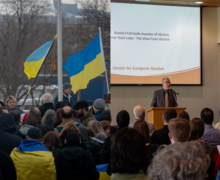Rodgers: Millenials have power to shift culture of gun violence, school shootings
While leaving Schine Student Center last Monday, I glanced up at the TV in the atrium to discover the breaking news story: a school shooting at Sparks Middle School in northern Nevada. One teacher killed, two students wounded.
Stopping in my tracks for a moment, I tried to understand the current situation. And as I found out more details later, I was even more shaken by the fact that a 12-year-old boy stood at the center of such a tragedy.
It is completely disheartening and troubling to know that mass shootings — especially in a school setting — are now happening at a much more frequent rate. According to Attorney General Eric Holder, the number of mass shootings in the United States has tripled in recent years, with the year 2013 alone accounting for at least 12 of such occurrences.
As a society, we now stand at a point in time where we can no longer view such tragedies as separate isolated incidents. We now face an urgent social problem in the form of mass shootings that requires immediate attention.
Preventing these disastrous moments requires immediate action not just in legislation or legal practices, but a complete shift in the American culture surrounding violence and bullying.
Millennials play a unique role in being the driving force behind such changes. As the next generation of educators, law enforcers and policy makers, we will serve as the catalysts to putting such changes into action.
But even without these titles, there are millennials already playing a part in the prevention of mass shootings.
Consider Sarah Clements of Newtown, Conn. After tragedy struck the town on Dec. 14, she began working with other young people in her area as a leader of the student action alliance.
Directing 100 percent of her efforts toward the youth, Clements understands that preventing mass shootings requires much more than just raising awareness.
“Cultural and legislative change intertwine,” Clements said. She describes how the branch of her alliance — the first student-run gun violence prevention program of its kind — creates action from young people.
“We teach students ways to lobby, talk to and write letters to government officials, and focus on mental health and education,” she said.
This type of direct action in the prevention of gun violence and mass shootings is sometimes overlooked.
And unfortunately, shootings persist.
Unlike Newtown, the most recent shooting in Nevada could have been influenced by bullying.
Eighth grader Amaya Newton described how an anti-bullying video shown to the middle school students may have prompted last Monday’s attack. The video depicted a girl’s retaliation to school bullies by bringing a gun onto her school bus.
Newton suggested that the movie “may have gotten into his head.”
When it comes to bullying, Clements believes that it is “clearly an overwhelming cause” of the number of gun violence incidents seen in schools. Dosomething.org reports “harassment and bullying have been linked to 75 percent of school-shooting incidents.”
By leading workshops, participating in conferences and having schools in different areas collaborate on different initiatives, Clements is a prime example of how millennials are working to create effective change in the prevention of mass shootings and gun violence.
Clements specifically spoke about a program implemented in schools in Norwalk, Conn. She said this program emphasizes the importance of “getting students to empathize and showing that you can have understanding.”
The program serves as the type of initiative millennials should be implementing across the country.
“It’s not just showing a video and saying don’t bully,” she says in regards to anti-bullying efforts. “We have to step it up.”
Nina Rodgers is a sophomore sociology major. Her column appears weekly. She can be reached at nmrodger@syr.edu.
Published on October 29, 2013 at 1:19 am





